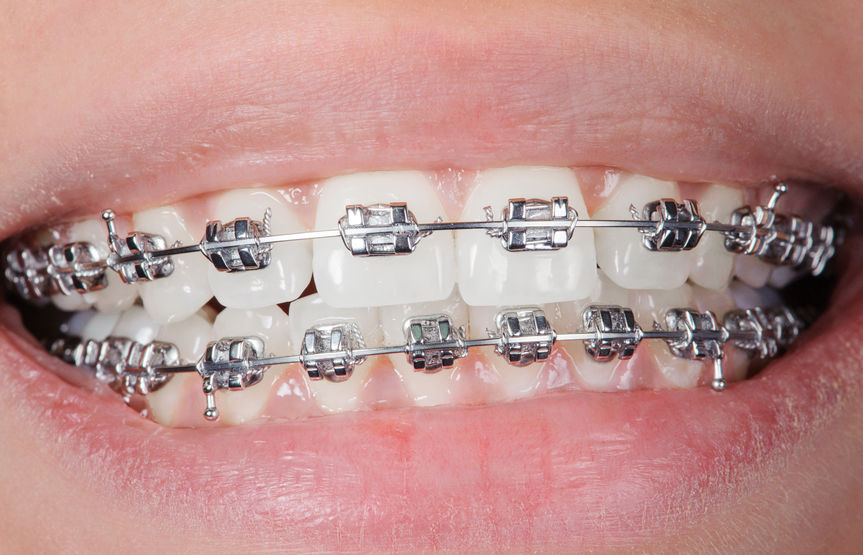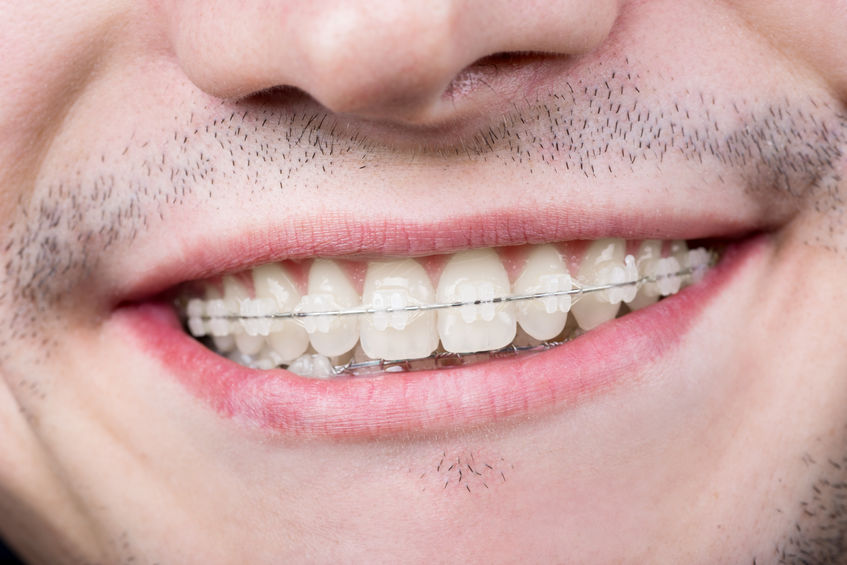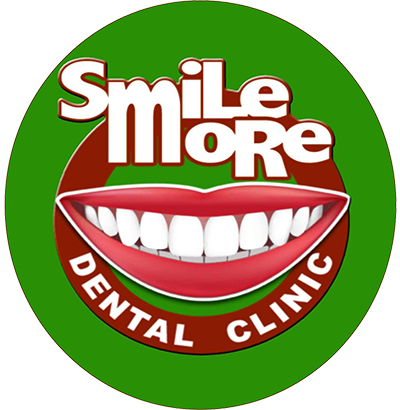Dental Braces
Braces are teeth straightening devices intended to correct alignment problems. As they are technically called, Orthodontics corrects the malocclusion or improper relationship between the teeth of the upper and lower jaws as they match each other. Through dental braces treatment, crooked teeth and malocclusion are corrected and refined. Such treatment will significantly affect the patient’s facial and dental aspect as the teeth are aligned to treat prominent underbite, overbite, or scissor-bite.

Who Needs to Have Dental Braces?
Overbite (Buck Teeth) — front upper teeth protrude out over the lower teeth
Underbite (Prognathism) – lower teeth extend outwards in relation to the upper front teeth
Deep bite (Closed Bite) — upper front teeth cover almost entirely the lower front teeth when they come together, showing a small portion of lower teeth or none at all
Open Bite — teeth do not come together or close in the front of your mouth; even with back teeth, an open bite can happen
Cross Bite (Reverse Bite) — lower teeth appear as protrusive with respect to the upper front teeth. Crooked teeth (Misaligned Teeth) commonly seen among children and adults – resulting in cosmetic, health, and speech problems.
Teeth spacing (Gaps between teeth) –– due to early loss of permanent molars and smaller teeth sizes, teeth spacing happens.
Jaw problems (TMJ) — jaw joint is situated in front of each ear; dysfunction of jaw joint results in distressing jaw problems.
Misaligned or Asymmetrical Jaw –– issues that relate to jaw position and sometimes requires surgery Overcrowded Teeth – due to smaller jaw size and bigger teeth that won’t fit on the entire jaw
Braces will include throughout its movement all pertinent teeth that will serve as holding components for the brackets, buccal tubes, and molar bands. The specialized archwire interlaced with rubber, fine ligature wires, or bracket hooks will correct the teeth alignment goal. The mentioned candidates above are ideal recipients for Dental Braces so that these patients can benefit from the treatment outcome.
TYPES OF DENTAL BRACES USED:
Metal Braces
This is the time-honored type of dental braces material and mainly represents the braces treatment or prototype of the Orthodontics field of dentistry. Though commonly used among younger teens and few adults, maintenance and manageability are easier despite the esthetic issue. So, one usual disapproval is that they are obvious. Most dentists practicing Orthodontics started their training with this type of ortho device.
The ideal turnaround to complete treatment is about 2 years, more or less for most cases. However, a process can be completed in 6 to 12 months, mainly if fewer or simple movements are necessitated.
During earlier years, the metal brackets worn are more prominent and do not look good. That is why they primarily represent the unpleasant phase or age of younger teens, referred to as the “nerd look” when paired with eyeglasses.
With the advent of fast-changing technology in dentistry, mini or tiny metal brackets are introduced. They can look relatively subdued. However, there occasions that they cannot substitute the standard metal brackets for more difficult teeth movement.
Throughout the treatment course, the pre-shaped archwires are attached to the brackets using rubbers and ligature wires. You might wonder why the dentist uses different elastics placed on various areas within or across the jaw. This is because the force application of these elastics moves the teeth.
If you want a quality treatment, the dentist must, for some reason, use a good brand of braces components doing substantial and compelling results. This fact explains why some dentists charge higher and other charge less. The competence and proficiency of the dentist likewise factor in the cost of dental braces.
Among the type of dental braces materials, the metal braces are less costly in price, with the disadvantage of looking more obvious or noticeable.

Ceramic Braces
The second option among braces materials tries to outdo the apparent look of metal type. They are almost similar in form and shape. They resemble tooth-color, making them appear almost inconspicuous. Only the archwires can be noticed when worn because clear elastics can complement the less noticeable appearance.
The downside of this braces material is that they are less durable in comparison to metal ones. Sometimes, the wings of the brackets used for holding archwires and rubbers get broken. Staining is also possible that implies another disadvantage. Hence, the patient should commit more frequent visits for maintenance, cleanings, and adjustment. In this manner, treatment can be done past-faced, just in time before the braces get damaged or chipped off. We instruct patients to always be careful in brushing their ceramic braces because a more forceful stroke can break them. Patients must also be responsible for eating soft or less hard foods to avoid damaging the brittle ceramic material. If a ceramic brace breaks at some point, it needs to be replaced and can mean additional cost to the patients’ account. But this can turn to be an advantage because frequent visits could mean faster treatment. The usual treatment span is around 1 1/2 to 2 years.
Self-Ligating Braces (Semi-adjusting Braces / Speed Braces)
This category of braces has been around for few years. They become popular because of their featured speed and comfortability. The teeth alignment and correction process occurs much quicker because this dental brace type includes a locking mechanism that holds the archwire instead of the elastic (rubber). The unique friction-free attribute of this material allows the dentist to perform teeth movement and occlusion improvement at a steady, swift, and effective pace. With less resistance than rubber’s pulling effect, the force received by the teeth is more comfortable. Self-Ligating Braces (also termed Damon Braces) have spring clips within the brackets, helping to move the teeth faster at reduced pressure and minor discomfort. Its hooks assure a more proficient correction goal, helping you save time yet can cost almost the same or higher than ceramic braces price.
We mentioned that Self-Ligating utilizes extremely light forces to move and shift teeth to any position required. Other soft tissue of the mouth, especially the gums, will be less prone to swelling, pain, and irritation with speed braces. Additionally, they correct malocclusion of the teeth and the jaw using effective use of pressure. Such features toss more on the cost of this braces type.
Speed braces are well-liked for their brief treatment time. The comfortable rounded and finer bracket design ensues less gum and cheek irritation. At the same time, the light force quickly shifts teeth to the desired position. Treatment with this braces material can take about 1 year or a little bit more, provided patients are reporting on scheduled treatment intervals. With that, expect that the cost of this ortho treatment material is more costly than does plain metal braces.
Invisalign
Invisalign are clear aligners that essentially move malaligned or malposed teeth. The treatment consists of having the patient wear 18 to 50 custom-made invisible aligner. Although patients can remove these aligners now and then, you have to be careful not to break or lose them. For a perfected outcome, patients need to change the aligners every 10 to 14 days.
Invisalign system is a U.S. patented technology. However, they cost more than previous classes of braces; they are almost invisible and appear like a thin plastic frame on top of the teeth. People will not notice that you are wearing them unless you get closer to them and allow them to inspect. So for most people in the movie industry, public figures, and patients who want to avoid the hassle of wearing and stuffing their teeth with bracket materials, this is the best choice possible.

Our clinic endorses Invisalign since we greatly rely on this brand. They already established a keystone in the dentistry trade. They relentlessly provide continuous learning and support to budding and seasoned dentists. We have witnessed the progress of the technology of this brand throughout the years.
Invisalign has a stake of limitations, like on severely categorized jaw relation and malocclusion. We can somehow say that they are best suited for simpler to moderate cases. The average turnaround for Invisalign Treatment is around 1 year to 1 ½ year.
Our recommendation for younger kids is to use metal braces because they are durable and difficult to remove. They can not be relied upon to keep the aligners, and they can easily lose them. Teenagers and adults are the ideal candidates to receive Invisalign.
The most common objection to why patients get discouraged from pursuing Invisalign is their high price.
Retainers
This orthodontic appliance is a must-have after the removal of all braces types. It helps preserve the outcome of dental alignment correction and helps avoid the bounce-back effect of the already corrected mal0cclusion. Patients are always instructed to wear them not to cause unseemly teeth movement that will mess the treatment outcome. If you can not wear them during the daytime, do wear them at night. But we emphasize continued use of dental retainers until we approved of you not wearing them.
